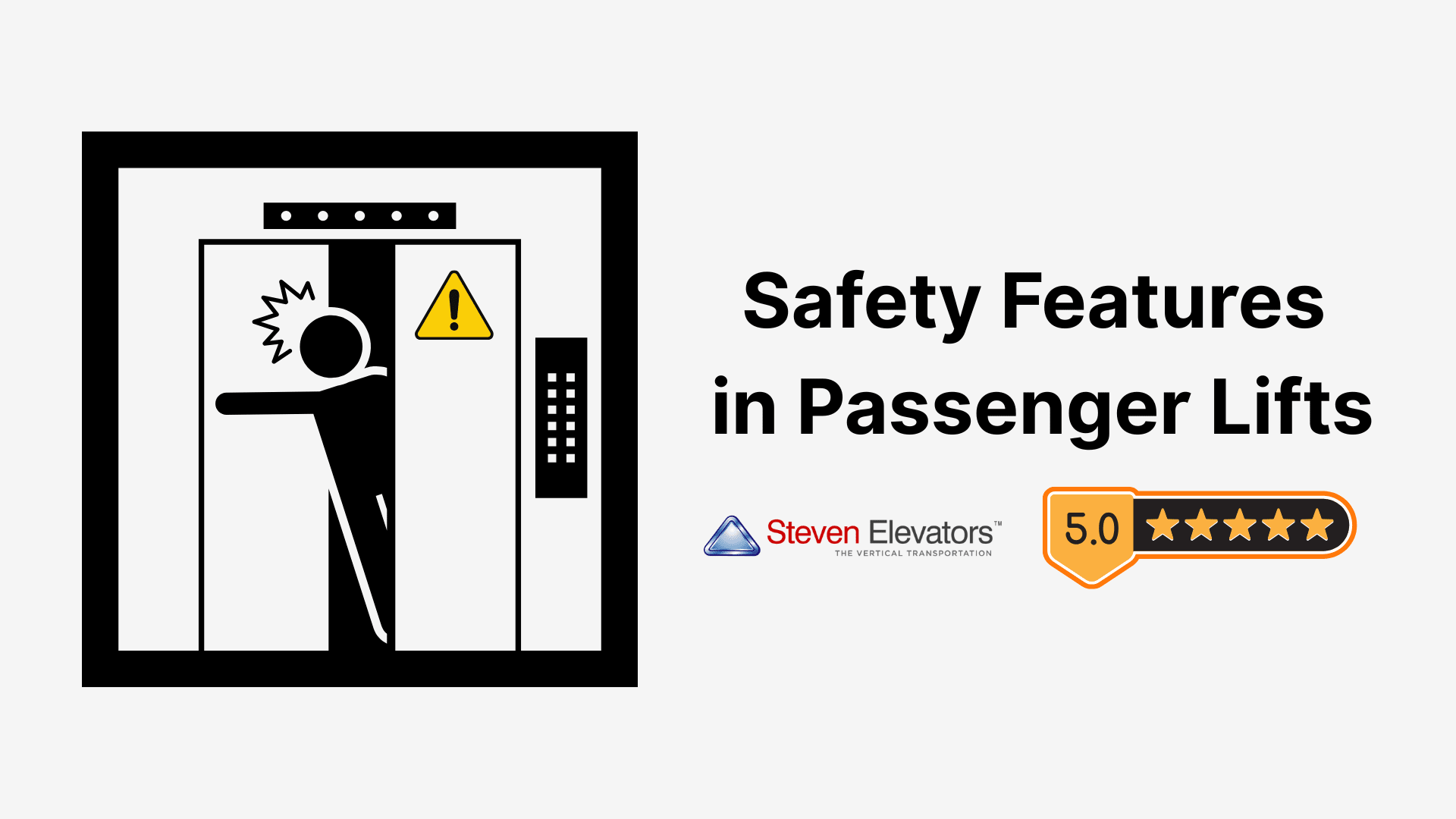Passenger elevators are among the safest methods of vertical transport in buildings. By design, modern lifts integrate advanced layers of protection to safeguard passengers during routine use, emergency events, and even rare malfunctions. Let’s explore how the safety features in passenger lifts, from mechanical safeguards to smart tech, work together to ensure your peace of mind.
Here are the Safety Features in Passenger Lifts
1. Emergency Braking & Speed Governors
One of the most critical safety features in passenger lifts is the speed governor paired with an emergency brake. If the elevator travels too fast—especially during a descent—these systems activate without delay:
- Speed governors detect over-speed conditions.
- Emergency brakes clamp onto the guide rails, bringing the car to an immediate halt.
This technology ensures that “falling elevators” remain a myth—elevators will not free-fall even in worst-case scenarios.
2. Door Interlocks & Object Sensors
Another frequent user concern is doors opening mid-ride. Modern passenger lifts include:
- Door interlock mechanisms prevent shaft movement unless doors are securely closed.
- Infrared and proximity sensors that detect limbs or objects, halting door movement to prevent entrapment.
3. Overload Detection Systems
Overloading a lift can strain its components and affect safe operation. That’s why all modern passenger lifts are equipped with:
- Overload sensors that trigger visual or audio alerts and stop the elevator from moving until the excess weight is removed.
4. Backup Power & Emergency Lighting
Power outages are unpredictable but manageable in a well-designed elevator. Safety measures include:
- Backup power supply (usually UPS or generator) to maintain lighting and allow safe evacuation or continuation to the nearest floor.
- Emergency lighting inside the shaft ensures passengers aren’t left in the dark during an outage.
5. Alarm & Two‑Way Communication
In the unlikely event of being trapped, passengers can quickly summon help via:
- Alarm buttons (buzzers/sirens)
- Two-way voice communication systems are directly connected to building security or support centers.
6. Ventilation & Air Circulation
Being stuck in a sealed cabin can be worrying. Fortunately, modern elevators incorporate:
- Ventilation vents or fans, designed so that air continues circulating even if power is lost.
7. Airflow Management & Infection Control
Amid heightened health awareness:
- Advanced HVAC strategies help control airborne infection risk. For instance, ceiling inlet/outlet systems can clean up to 79% of particles during rides.
8. Advanced Surveillance & Access Control
Passenger security goes beyond mechanical tools. Advanced safety features in passenger lifts now include:
- CCTV cameras
- Keycard or biometric access controls
- Alarm monitoring systems
These features are essential in multi-tenant or high-security buildings.
9. Redundant Safety Measures & Inspection Modes
Redundancy is key:
- Dual braking systems, backup sensors, and fail-safe designs ensure no single failure causes an accident.
- Inspection, fire-service, and service modes allow trained personnel or emergency responders to override regular operations, ensuring safe, controlled movement.
10. Fall‑Detection AI & Predictive Safety Tech
The future of elevator safety uses AI:
- For example, a deep‑learning camera system using YOLOv8 Nano achieved 85% precision in detecting falls in elevators.
- Other emerging systems integrate tinyML for contactless buttons and voice commands, reducing physical surfaces and enhancing hygiene.
Why These Safety Features Matter
Consider the latest statistics:
- In India, elevator accidents cause around 30–40 deaths and 45 injuries every year, with many cases linked to maintenance issues, power failures, or lack of rescue features. In Tamil Nadu, incidents like the KP Park lift fatality in Chennai (2024) highlight the urgent need for features like automatic rescue devices (ARDs) and UPS backups.
- Globally, only 900 lift accidents cause injury each year a testament to advanced engineering that saves millions of users daily
Modern safety features in passenger lifts directly reduce these risks, protecting both everyday users and maintenance staff.
Enhance Your Lift Safety with Steven Elevators
Steven Elevators, Chennai’s leading passenger lift manufacturer, offers a full suite of safety features in passenger lifts:
- Mechanical redundancies (governors & brakes)
- Smart sensors (overload, door, and fire)
- Backup power & emergency lighting
- CCTV and access control integration
- Two-way communication and alarm systems
- Optional AI-based fall detection and hygiene features
As a lending lift manufacturers in Chennai, we engineer every lift to meet the strictest safety and compliance standards, tailored for South Indian buildings’ needs.
Learn More or Get a Free Safety Audit!
Before you go:
- Want a free lift-safety audit?
- Looking to integrate AI-powered safety systems, contactless controls, or advanced ventilation?
- Need multi-level access with CCTV and secure entry?
Contact Steven Elevators today. As experts in safety-driven, compliant passenger lifts, we’re ready to design, install, and service your next elevator, ensuring your building meets the highest safety standards.
Conclusion
In the world of vertical transport, safety features in passenger lifts are not optional—they’re essential. From emergency braking and overload sensors to AI‑powered detection and secure access, modern elevators ensure smooth, safe rides every time.
At Steven Elevators, we weave cutting-edge technology with purpose-built design to put safety first. If you’re searching for reliable, secure elevator solutions in Chennai, let’s elevate your expectations—starting with a conversation.
Elevate safer. Elevate smarter. Choose Steven Elevators.

